Abstract
This study investigated the hydrogen-related fracture behavior in as-quenched low-carbon martensitic steel under a constant loading tensile test with various applied stresses. We found that the fracture time in the constant loading tensile test decreased as the applied stress and hydrogen content increased. The fracture surface topography analysis revealed that when the applied stress was low, the intergranular fracture was initiated around the side surface of the specimen and gradually propagated into the inner part of the specimen. In contrast, several intergranular fractures were separately initiated inside the specimen when the applied stress was high. The mode of hydrogen-related fracture was controlled by the fracture stress and not by the global hydrogen content inside the specimen. Increasing the global hydrogen content caused a decrease in the duration required for the accumulation of critical local hydrogen concentration at the fracture initiation site (prior austenite grain boundary). Accordingly, we propose that the local state at the crack initiation site is constant under a given applied stress, even when the global hydrogen content is different.
1. Introduction
Hydrogen often degrades the mechanical properties of metals and alloys; this degradation is referred to in the literature as “hydrogen embrittlement”, “hydrogen-related fracture”, “delayed fracture”, and so on [1]. It is well-known that the sensitivity to hydrogen embrittlement increases with increasing strength of steels. High-strength steels, particularly martensitic steels, exhibit considerably high susceptibility to hydrogen embrittlement, which severely hinders the practical implementation of high-strength steels such as in automobile bodies.
The two typical fracture modes of hydrogen embrittlement in martensitic steels are quasi-cleavage and intergranular fractures. Quasi-cleavage fractures occur in a transgranular manner inside prior austenite grains [1,2]. Crystallographic orientation analysis revealed that the hydrogen-related quasi-cleavage fracture often occurred along the {011} plane, not along the typical cleavage plane in a body-centered cubic (BCC) structure (i.e., the {001} plane) [3,4,5,6,7,8]. In contrast, intergranular fractures mainly propagate along prior austenite grain boundaries [9,10,11,12], despite the martensitic structure containing several types of high-angle boundaries, in addition to prior austenite grain boundaries, namely, block boundaries and packet boundaries [13,14]. In many cases, intergranular fractures result in more severe brittle behavior during hydrogen embrittlement.
Wang et al. [15] studied the hydrogen-related fracture behavior of martensitic steel through tensile tests. They found that quasi-cleavage fracture occurred in specimens with a small amount of diffusible hydrogen (less than 0.5 wt. ppm). In contrast, when the hydrogen content was high (more than 0.5 wt. ppm), the fracture modes became intergranular, and the maximum tensile stress decreased following a power–law relationship with diffusible hydrogen content. Hagihara et al. [16] reported a similar tendency; the increasing hydrogen content resulted in lower fracture stress and transition of fracture mode from quasi-cleavage to intergranular.
Hydrogen accumulation during deformation plays a crucial role in hydrogen-related fracture behavior [17,18,19]. Previously, we studied the local hydrogen accumulation behavior during deformation using a hydrogen micro-print technique [20]. The hydrogen accumulated around the prior austenite grain boundaries during the tensile test at a low strain rate (8.3 × 10−6 s−1), whereas the hydrogen was distributed uniformly after deformation at a high strain rate (8.3 × 10−1 s−1). This accumulation behavior was linked to the mechanical properties of the material because the ultimate tensile strength and total elongation of the hydrogen-charged specimen decreased with decreasing strain rate [20].
Wang et al. [21] studied the condition of hydrogen-related fracture using notched specimens with different notch root radii and proposed that the local stress field (maximum principal stress) and local hydrogen content controlled the intergranular fracture. Recently, we also revealed that the stress level and hydrogen content at the initiation sites of intergranular cracks were almost the same, regardless of the stress concentration factor of the notched specimens [22].
Because the fracture mode is directly related to the susceptibility to hydrogen embrittlement [15,16], it is very important to understand the distinct conditions controlling the fracture mode in hydrogen embrittlement. A simple tensile test is not suitable to study the factor controlling hydrogen-related fracture mode because local state (stress, strain, and hydrogen content) continuously changes during the test. The present study employed a constant loading tensile test and investigated the hydrogen-related fracture behavior under various applied stresses.
2. Materials and Methods
The material used in this study was Fe–8Ni–0.1C (wt. %) alloy. Its chemical composition by wt. % was C: 0.116, Si: 0.005, Mn: 0.01, P: 0.001, S: 0.0015, Al: 0.033, Ni: 7.94, and Fe: balance. A cast ingot of the steel was cold-rolled to a thickness of approximately 1.7 mm and austenitized at 1000 °C for 30 min in vacuum, followed by iced-brine quenching and sub-zero cooling in liquid nitrogen. After the austenitization treatment, the specimen exhibited a fully martensitic structure. Both sides of the heat-treated specimen were mechanically ground to a thickness of approximately 1 mm to remove the decarburized layers formed during the austenitization treatment.
Sheet-type tensile test specimens with a gauge length of 10 mm, gauge width of 5 mm, and gauge thickness of 1 mm were cut from the heat-treated specimens via spark wire cutting. Hydrogen was pre-charged into the specimen by electrochemical charging in an aqueous solution containing 3% NaCl and 3 g L−1 NH4SCN for 24 h at ambient temperature. A platinum plate was used as the counter electrode, and three kinds of current densities were employed: 0.1 A m−2, 1.0 A m−2, and 3.0 A m−2. Thermal desorption analysis was conducted at a heating rate of 100 °C h−1 using quadrupole mass spectrometry (R-DEC: HTDS-002) to measure the diffusible hydrogen content (HD). A standard leak hydrogen gas system using a crimper capillary was used for calibration. Calibration was performed before each hydrogen desorption measurement. HD was defined as the cumulative hydrogen content desorbed from room temperature to 300 °C, where the first desorption rate peak ended. The measured HD was 0.06 wt. ppm (0.1 A m−2), 0.47 wt. ppm (2.0 A m−2), and 0.80 wt. ppm (3.0 A m−2). After hydrogen pre-charging, slow strain rate tensile tests (initial strain rate: 8.3 × 10−6 s−1) and constant loading tensile tests under various applied stresses ranging from 400 to 1150 MPa were performed at ambient temperature using a universal testing machine (Shimadzu: AG-1/100 kN (the slow strain rate tensile test)) and a servo-hydraulic machine (Shimadzu: SERVO EHFEV101k1 (the constant loading tensile test)). In order to ensure reproducibility, the slow strain tensile test and constant loading tensile test were replicated at least twice (except for the constant loading tensile test of the uncharged specimen). To prevent the desorption of hydrogen from the specimen, hydrogen charging under the same pre-charging condition described above was performed during the constant loading tensile test (but not during the slow strain rate tensile test).
The fracture surfaces of the tested specimens were observed using scanning electron microscopy (SEM, JEOL: JSM-7100F and JSM-7800F). Crystal orientation mapping at the mid-thickness sections of the tested specimens was performed by electron backscattering diffraction (EBSD) using SEM at an acceleration voltage of 15 kV. To investigate the fracture process, fracture surface topography analysis (FRASTA) was employed. FRASTA is a method for computationally reconstructing a fracture process such as crack initiation and propagation behaviors by comparing the topographic features of the fracture surfaces. The detailed procedure for FRASTA was described in previous studies [23,24,25], and consists of three steps: (a) obtaining topographic maps of the identical areas in two opposing fracture surfaces; (b) computationally superimposing the maps until there was no gap between them; and (c) virtually separating them in the loading direction. Because the gaps that appear correspond to the fractured areas, the fracture propagation process can be reconstructed through the gap formation sequence by increasing the relative distance between the two topographic maps. Herein, three-dimensional fracture surface images were reconstructed from stereoscopic SEM images (tilt angle: −5°, 0°, +5°) using the Mex 5.1 software (Alicona; Graz; Austria). The free Image J software was used to overlap the reconstructed topographic maps and separate them in the loading direction.
3. Results
Figure 1a shows the engineering stress–engineering strain curves of the slow strain rate tensile tests. The 0.2% proof stress and ultimate tensile strength of the uncharged specimen were 931 MPa and 1283 MPa, respectively. The elongation decreased with increasing HD, and the specimens with HD of 0.47 wt. ppm and 0.80 wt. ppm exhibited premature fracture within the apparent elastic strain regime. The relationship between the applied stress and fracture time obtained from the constant loading tensile tests is presented in Figure 1b, where the plots of black, red, green, and blue indicate the data of the uncharged specimen, hydrogen-charged specimen with HD = 0.06 wt. ppm, hydrogen-charged specimen with HD = 0.47 wt. ppm, and hydrogen-charged specimen with HD = 0.80 wt. ppm, respectively. The uncharged specimen did not fracture until 106 s under an applied stress of 1150 MPa (maximum stress used in the present constant loading tensile tests). In contrast, fracture occurred within 10 s under an applied stress of 1000 MPa in the hydrogen-charged specimens with HD = 0.47 wt. ppm and 0.80 wt. ppm. The fracture time tended to decrease with increasing applied stress and HD.
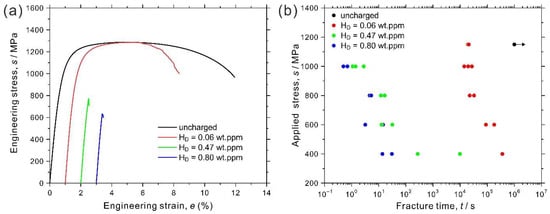
Figure 1.
(a) Engineering stress–engineering strain curves of the specimens with different HD in the slow strain rate tensile tests and (b) relationship between the applied stress and fracture time in the constant loading tensile tests.
We confirmed that the fracture surfaces consisted of intergranular surfaces, quasi-cleavage surfaces, and ductile surfaces with dimple patterns, regardless of testing type (constant loading tensile test or slow strain rate tensile test), applied stress, and HD. SEM images of the typical fracture surfaces are shown in Figure 2: intergranular surface (Figure 2a) and quasi-cleavage surface (center area of the image) (Figure 2b) observed in the hydrogen-charged specimen with HD = 0.80 wt. ppm after the slow strain rate tensile test. Previous studies [3,4,5,6,7,8,9,10,11,12] suggest that hydrogen-related intergranular fractures occur on the prior austenite grain boundaries and quasi-cleavage fracture propagates along the {011} crystallographic plane within the lath. Several micro-cracks were observed in the vicinity of the fracture surface after the slow strain rate tensile tests and constant loading tensile tests. Figure 3 presents the SEM images (Figure 3a,c) and corresponding EBSD orientation maps (Figure 3b,d) of the areas around the micro-cracks in the specimens with HD = 0.80 wt. ppm after the constant loading tensile tests under an applied stress of 400 MPa (Figure 3a,b) and 800 MPa (Figure 3c,d). The colors in the EBSD orientation map express the crystallographic orientations along the normal direction of the observed section according to the stereographic triangle. In addition, the positions of the prior austenite grain boundaries identified by orientation analysis are indicated by the broken white lines. In both specimens, after constant loading tensile tests under an applied stress of 400 MPa and 800 MPa, micro-cracks formed along the prior austenite grain boundaries. Because the formation of micro-cracks can be regarded as the initial stage of fracture, the results indicate that the initiation site of the hydrogen-related fracture was prior austenite grain boundaries and did not change with the applied stress. Previous studies also reported that hydrogen-related cracks were initiated around prior austenite grain boundaries [7,22].
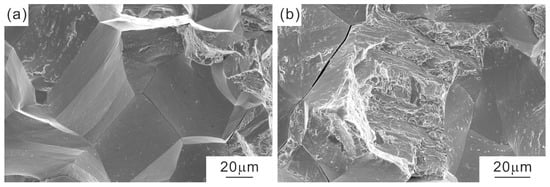
Figure 2.
SEM images of the typical fracture surfaces; (a) intergranular surface and (b) quasi-cleavage surface (center area of the image) of the hydrogen-charged specimen with HD = 0.80 wt. ppm after the slow strain rate tensile test.
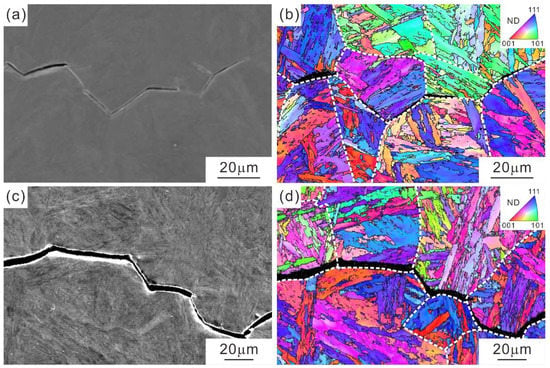
Figure 3.
(a,c) SEM images and (b,d) corresponding EBSD orientation maps of the areas around the micro-cracks in the specimens with HD = 0.80 wt. ppm after the constant loading tensile tests under an applied stress of (a,b) 400 MPa and (c,d) 800 MPa. The positions of the prior austenite grain boundaries identified by orientation analysis are indicated by the broken white lines.
The hydrogen-related fracture propagation process in the specimen with HD = 0.80 wt. ppm after the constant loading tensile test with an applied stress of 400 MPa (lower than the 0.2% proof stress) (Figure 1a) was reconstructed by FRASTA, and the results superimposed on the fracture surface SEM images are presented in Figure 4. L in the figure is the distance between the two fracture surface topographic maps and is defined as 0 when all the areas of the two topographic maps completely overlap (Figure 4a). The fractured areas, that is, the gaps between two topographic maps, are represented by blue, green, and red, which correspond to the intergranular fracture at prior austenite grain boundaries, the quasi-cleavage fracture, and the ductile fracture with dimples, respectively. The intergranular fracture (blue area) initiated around the side surface of the specimen (lower part of Figure 4b) and gradually propagated toward the inner part of the specimen (Figure 4c–f). In contrast, the quasi-cleavage fracture (green area) was discontinuous. Almost all areas of quasi-cleavage fracture were connected to the intergranular fracture area, indicating that the quasi-cleavage fractures were initiated from the existing intergranular cracks. The ductile fracture (red area), accompanied by the formation of dimples, occurred in the final rupture process (upper part of Figure 4e–g). Previously, we studied the microscopic crack propagation behavior of hydrogen-related intergranular fractures in a low-carbon martensitic steel and reported that the intergranular crack occasionally deviated from the prior austenite grain boundary and propagated within the prior austenite grains in a quasi-cleavage manner [26]. Presumably, once the crack stops propagating along the prior austenite grain boundaries due to geometrical/crystallographic grain boundary parameters, the crack starts to propagate within the prior austenite grain in a quasi-cleavage manner. After reaching another prior austenite grain boundary, the crack propagates along the prior austenite grain boundary again. Figure 5 presents the hydrogen-related fracture propagation process reconstructed by FRASTA in the specimen with HD = 0.80 wt. ppm after the constant loading tensile test with an applied stress of 1000 MPa (higher than the 0.2 % proof stress) (Figure 1a). The results indicate that several intergranular fractures (blue area) were initiated separately inside the specimen (Figure 5b,d). This indicates that a higher applied stress facilitated the initiation of hydrogen-related cracks around the prior austenite grain boundaries. As the fracture proceeded, the fractions of the quasi-cleavage fracture (green area) and ductile fracture (red area) increased (Figure 5c–g). Compared with Figure 4 (applied stress: 400 MPa), the transition from intergranular to quasi-cleavage occurred at a relatively earlier stage of fracture when the applied stress was 1000 MPa (Figure 5).
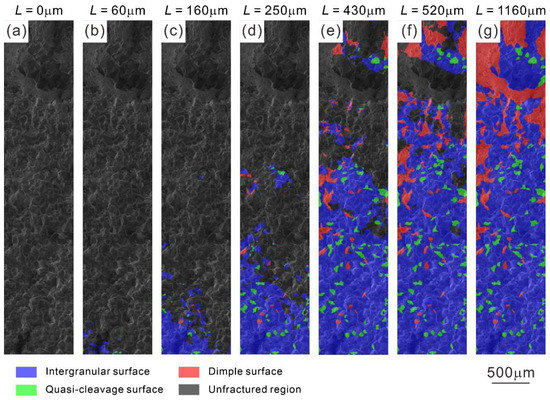
Figure 4.
Fracture propagation process reconstructed by FRASTA in the specimen with HD = 0.80 wt. ppm after the constant loading tensile test with an applied stress of 400 MPa (lower than the 0.2% proof stress). The fractured areas (blue: intergranular fracture, green: quasi-cleavage fracture, and red: ductile fracture) are superimposed on the fracture surface SEM images. L in the figure is the distance between the two fracture surface topographic maps; (a) 0 μm, (b) 60 μm, (c) 160 μm, (d) 250 μm, (e) 430 μm, (f) 520 μm, and (g) 1160 μm.
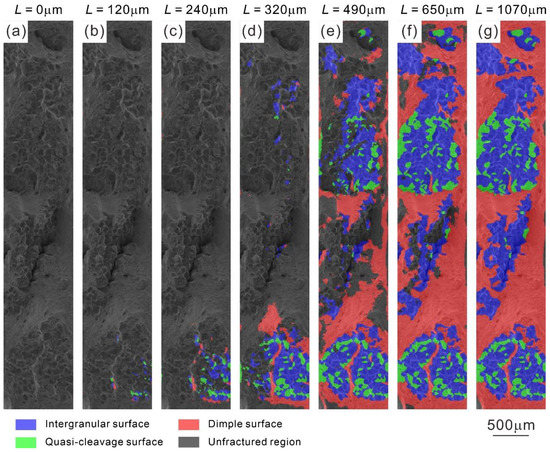
Figure 5.
Fracture propagation process reconstructed by FRASTA in the specimen with HD = 0.80 wt. ppm after the constant loading tensile test with an applied stress of 1000 MPa (higher than the 0.2% proof stress). The fractured areas (blue: intergranular fracture, green: quasi-cleavage fracture, and red: ductile fracture) are superimposed on the fracture surface SEM images. L in the figure is the distance between the two fracture surface topographic maps; (a) 0 μm, (b) 120 μm, (c) 240 μm, (d) 320 μm, (e) 490 μm, (f) 650 μm, and (g) 1070 μm.
Figure 6a summarizes the area fractions of hydrogen-related fracture surfaces among the total fracture surfaces as a function of applied stress in the constant loading tensile test and fracture stress in the slow strain rate tensile test. The data were obtained using SEM images of the whole fracture surface. Each plot of the slow strain rate tensile test had a different HD. We can confirm that the hydrogen-related fracture surface, that is, intergranular and quasi-cleavage, tended to decrease with increasing applied stress (or fracture stress). As shown in the fracture process reconstructed via FRASTA (Figure 4 and Figure 5), ductile surfaces (other than hydrogen-related fracture surface) formed during the final rupture process. Thus, the results in Figure 6a indicate that the unstable final fracture occurred earlier when the applied stress was high. The area fractions of the intergranular and quasi-cleavage surfaces among the hydrogen-related fracture surfaces are plotted as a function of the applied stress (fracture stress) in Figure 6b. All specimens exhibited the same tendency regardless of HD; the fraction of quasi-cleavage fracture increased (i.e., the fraction of intergranular fracture decreased) with increasing applied stress. This indicates that a higher applied stress promoted a quasi-cleavage fracture. Notably, the fractions of quasi-cleavage and intergranular surfaces did not significantly change with HD. That is, HD did not affect the mode of hydrogen-related fracture, although the fracture time significantly decreased with increasing HD (Figure 1b).
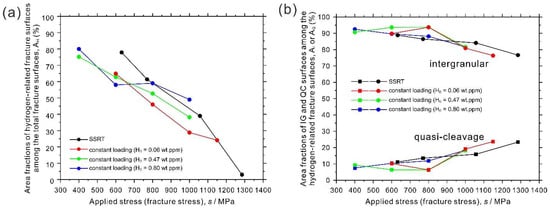
Figure 6.
(a) Area fractions of hydrogen-related fracture surfaces among the total fracture surfaces as a function of applied stress in the constant loading tensile test and fracture stress in the slow strain rate tensile test. (b) Area fractions of intergranular and quasi-cleavage surfaces among the hydrogen-related fracture surfaces as a function of applied stress in the constant loading tensile test and fracture stress in the slow strain rate tensile test. Each plot of the slow strain rate tensile test had a different HD.
4. Discussion
The hydrogen-related fracture was time-dependent: hence, the hydrogen-related fractures are sometimes called “delayed fractures”. As shown in Figure 1b, the fracture time of the hydrogen-charged specimen decreased as the applied stress or HD increased. Reportedly, the accumulation of a certain amount of hydrogen at a specific site is necessary for the initiation of a hydrogen-related fracture [27]. Figure 3 shows that the initiation site of the hydrogen-related fracture in the martensitic steel was the prior austenite grain boundaries. Moreover, recent studies using the hydrogen micro-print technique [20] have suggested that hydrogen accumulated around the prior austenite grain boundaries during deformation. Therefore, as shown in Figure 1b, a higher applied stress and larger global HD facilitated hydrogen accumulation at the prior austenite grain boundaries. As shown in the fracture propagation process under a higher applied stress (Figure 5), several intergranular fractures were initiated inside the specimen. This may be attributed to the critical local hydrogen concentration being easily achieved at many sites when the applied stress is high. In contrast, it can be assumed that a lower applied stress retards hydrogen accumulation, leading to less nucleation of intergranular fracture. Therefore, once the intergranular crack is initiated, the fracture mainly proceeds by the propagation of the existing crack (Figure 4).
Because the mode of hydrogen-related fracture did not change significantly with HD (Figure 6b), we propose that the fracture mode in hydrogen embrittlement is controlled by fracture stress and not by global HD inside the specimen. We previously studied hydrogen-related fracture behavior using double-notched tensile test specimens with different stress concentration factors, and we showed that the intergranular cracks were initiated under almost the same local stress field and local hydrogen concentration, despite the stress concentration factors being different [22]. Therefore, the critical local hydrogen concentration for the initiation of hydrogen-related intergranular cracks can be simplified as a function of the applied stress. The increasing global HD in the specimen decreases the period necessary for the accumulation of critical local hydrogen concentration at the fracture initiation site, leading to a decrease in fracture time (Figure 1b). However, the local state at the crack initiation site (particularly the local hydrogen concentration) is constant under a given applied stress, even when the global HD is different. Accordingly, the fracture mode (fractions of intergranular and quasi-cleavage) did not change with global HD, as shown in Figure 6b. In contrast, it is well-known that the mode of hydrogen-related fracture changes with global HD in tensile tests [16]. In contrast to the constant loading tensile test, the applied stress continuously increased during hydrogen accumulation at the fracture initiation site in the tensile test. We suppose that the fracture starts to occur when the local hydrogen concentration reaches a critical concentration for the applied stress at that time. That is, the fracture stress changes with the global HD. The results in Figure 6b support this conclusion because the fracture mode was almost the same between the constant loading tensile test and slow strain rate tensile test when the fracture stresses were identical. Here, we should note that global HD at the fracture could be different from the listed value. As described above, HD was measured using the pre-charged specimen before testing. The hydrogen charging was performed during the constant loading tensile tests but not during the slow strain rate tensile tests. Therefore, the global HD at the fracture could be larger in the constant loading tensile test and smaller in the slow strain rate tensile test than the listed HD. However, the important finding in the present study was that the mode of hydrogen-related fracture was controlled by fracture stress and not by the global HD. Accordingly, even when the global HD at the fracture was different to that after pre-charging, the conclusion does not change at all as the global HD itself did not affect the fracture mode.
Several studies suggest that plastic deformation plays a crucial role in hydrogen-related quasi-cleavage fracture [28,29,30,31,32]. Takeda and McMahon reported that quasi-cleavage fractures corresponded to strain-controlled fractures [3]. Based on finite element simulation, we also demonstrated that the plastic strains were maximized at the quasi-cleavage crack initiation sites [22]. Because the higher applied stress promotes plastic deformation, the increase in quasi-cleavage fractures were observed as the applied stress increased (Figure 6b), which is consistent with previous studies.
5. Conclusions
In this study, we investigated hydrogen-related fracture behavior under a constant loading tensile test in as-quenched low-carbon martensitic steel. The following conclusions were drawn:
- The fracture time in the constant loading tensile test decreased as the applied stress and HD increased. When the applied stress was high (1000 MPa) and HD was large (more than 0.47 wt. ppm), the fractures occurred within 10 s. The fracture initiation site was the prior austenite grain boundaries, regardless of the applied stress. Consequently, we speculate that the fracture time in the constant loading tensile test corresponded to the requisite period to achieve the critical local hydrogen concentration at the prior austenite grain boundaries for the initiation of intergranular cracking.
- The fracture propagation process reconstructed via FRASTA revealed that when the applied stress was low (400 MPa), the intergranular fracture was initiated around the side surface of the specimen and gradually propagated into the inner part of the specimen. Quasi-cleavage fractures were initiated from existing intergranular cracks. In contrast, several intergranular fractures were initiated separately inside the specimen when the applied stress was high (1000 MPa).
- The hydrogen-related fracture surface (intergranular and quasi-cleavage) tended to decrease as the applied stress (or fracture stress) increased, indicating that the unstable final fracture occurred earlier when the applied stress was high. Moreover, a higher applied stress promoted the quasi-cleavage fracture. This could be because quasi-cleavage fracture corresponds to a strain-controlled fracture.
- The mode of hydrogen-related fracture was controlled by fracture stress and not by the global HD inside the specimen. Increasing the global HD decreased the necessary period for the accumulation of critical local hydrogen concentration at the fracture initiation site. We propose that the local state at the crack initiation site (including local hydrogen concentration) was constant under a given applied stress, even when the global HD was different.
Author Contributions
Conceptualization, A.S. and N.T.; Methodology, A.S. and Y.T.; Validation, A.S. and Y.T.; Investigation, A.S., Y.T. and Y.K.; Data curation, A.S. and Y.T.; Writing—original draft preparation, A.S.; Writing—review and editing, A.S., Y.T., Y.K. and N.T.; Visualization, A.S.; Project administration, A.S.; Funding acquisition, A.S. and N.T. All authors have read and agreed to the published version of the manuscript.
Funding
This study was financially supported by the JSPS KAKENHI (Grant Numbers JP15H04158, JP19H02459, and JP20K21083) and the Elements Strategy Initiative for Structural Materials (ESISM) through MEXT Japan.
Data Availability Statement
The raw and processed data required to reproduce these findings cannot be shared at this time as the data also form part of an ongoing study.
Acknowledgments
The authors sincerely thank Yuji Momotani (Kyoto University), Takashi Yonemura (Kyoto University), and Hinako Gomori (NIMS) for helping with the experiments.
Conflicts of Interest
The authors declare no conflict of interest.
References
- Robertson, I.M.; Sofronis, P.; Nagao, A.; Martin, M.L.; Wang, S.; Gross, D.W.; Nygren, K.E. Hydrogen Embrittlement Understood. Metall. Mater. Trans. B 2015, 46, 1085–1103. [Google Scholar] [CrossRef]
- Lynch, S.P. A Fractographic Study on Gaseous Hydrogen Embrittlement and Liquid-Metal Embrittlement in a Tempered-Martensitic Steel. Acta Metall. 1984, 32, 79–90. [Google Scholar] [CrossRef]
- Takeda, Y.; McMahon, C.J., Jr. Strain Controlled vs Stress Controlled Hydrogen Induced Fracture in a Quenched and Tempered Steel. Metall. Mater. Trans. A 1981, 12, 1255–1266. [Google Scholar] [CrossRef]
- Kim, Y.H.; Morris, J.W., Jr. The Nature of Quasicleavage Fracture in Tempered 5.5Ni Steel after Hydrogen Charging. Metall. Mater. Trans. A 1983, 14, 1883–1888. [Google Scholar] [CrossRef]
- Kim, Y.H.; Kim, H.J.; Morris, J.W., Jr. The Influence of Precipitated Austenite on Hydrogen Embrittlement in 5.5Ni Steel. Metall. Mater. Trans. A 1986, 17, 1157–1164. [Google Scholar] [CrossRef]
- Nagao, A.; Smith, C.D.; Dadfarnia, M.; Sofronis, P.; Robertson, I.M. The role of hydrogen in hydrogen embrittlement fracture of lath martensitic steel. Acta Mater. 2012, 60, 5182–5189. [Google Scholar] [CrossRef]
- Shibata, A.; Takahashi, H.; Tsuji, N. Microstructural and Crystallographic Features of Hydrogen-related Crack Propagation in Low Carbon Martensitic Steel. ISIJ Int. 2012, 52, 208–212. [Google Scholar] [CrossRef] [Green Version]
- Shibata, A.; Momotani, Y.; Murata, T.; Matsuoka, T.; Tsuboi, M.; Tsuji, N. Microstructural and crystallographic features of hydrogen-related fracture in lath martensitic steels. Mater. Sci. Technol. 2017, 33, 1524–1532. [Google Scholar] [CrossRef]
- Banerji, S.K.; McMahon, C.J., Jr.; Feng, H.C. Intergranular Fracture in 4340-Type Steels: Effects of Impurities and Hydrogen. Metall. Mater. Trans. A 1978, 9, 237–247. [Google Scholar] [CrossRef]
- Craig, B.; Krauss, G. The Structure of Tempered Martensite and Its Susceptibility to Hydrogen Stress Cracking. Metall. Mater. Trans. A 1980, 11, 1799–1808. [Google Scholar] [CrossRef]
- Lee, S.J.; Ronevich, J.A.; Kurauss, G.; Matlock, D.K. Hydrogen Embrittlement of Hardened Low-carbon Sheet Steel. ISIJ Int. 2010, 50, 294–301. [Google Scholar] [CrossRef] [Green Version]
- Shibata, A.; Madi, Y.; Okada, K.; Tsuji, N.; Besson, J. Mechanical and microstructural analysis on hydrogen-related fracture in a martensitic steel. Int. J. Hydrogen Energy 2019, 44, 29034–29046. [Google Scholar] [CrossRef]
- Morito, S.; Tanaka, H.; Konishi, R.; Furuhara, T.; Maki, T. The morphology and crystallography of lath martensite in Fe-C alloys. Acta Mater. 2003, 51, 1789–1799. [Google Scholar] [CrossRef]
- Morito, S.; Huang, X.; Furuhara, T.; Maki, T.; Hansen, N. The morphology and crystallography of lath martensite in alloy steels. Acta Mater. 2006, 54, 5323–5331. [Google Scholar] [CrossRef]
- Wang, M.; Akiyama, E.; Tsuzaki, K. Hydrogen degradation of a boron-bearing steel with 1050 and 1300MPa strength levels. Scr. Mater. 2005, 52, 403–408. [Google Scholar] [CrossRef]
- Hagihara, Y.; Shobu, T.; Hisamori, N.; Suzuki, H.; Takai, K.; Hirai, K. Delayed fracture using CSRT and hydrogen trapping characteristics of V-bearing high-strength steel. ISIJ Int. 2012, 52, 298–306. [Google Scholar] [CrossRef] [Green Version]
- Sofronis, P.; McMeeking, R.M. Numerical analysis of hydrogen transport near a blunting crack tip. J. Mech. Phys. Solids 1989, 37, 317–350. [Google Scholar] [CrossRef]
- Krom, A.H.M.; Maier, H.J.; Koers, R.W.J.; Bakker, A. The effect of strain rate on hydrogen distribution in round tensile specimens. Mater. Sci. Eng. A 1999, 271, 22–30. [Google Scholar] [CrossRef]
- Dadfarnia, M.; Martin, M.L.; Nagao, A.; Sofronis, P.; Robertson, I.M. Modeling hydrogen transport by dislocations. J. Mech. Phys. Solids 2015, 78, 511–525. [Google Scholar] [CrossRef]
- Momotani, Y.; Shibata, A.; Terada, D.; Tsuji, N. Effect of strain rate on hydrogen embrittlement in low-carbon martensitic steel. Int. J. Hydrogen Energy 2017, 42, 3371–3379. [Google Scholar] [CrossRef]
- Wang, M.; Akiyama, E.; Tsuzaki, K. Effect of hydrogen and stress concentration on the notch tensile strength of AISI 4135 steel. Mater. Sci. Eng. A 2005, 398, 37–46. [Google Scholar] [CrossRef]
- Shibata, A.; Yonemura, T.; Momotani, Y.; Park, M.-h.; Takagi, S.; Madi, Y.; Besson, J.; Tsuji, N. Effects of local stress, strain, and hydrogen content on hydrogen-related fracture behavior in low-carbon martensitic steel. Acta Mater. 2021, 210, 116828. [Google Scholar] [CrossRef]
- Kobayashi, T.; Shockey, D.A. A Fractographic Investigation of Thermal Embrittlement in Cast Duplex Stainless Steel. Metall. Mater. Trans. A 1987, 18, 1941–1949. [Google Scholar] [CrossRef]
- Kobayashi, T.; Shockey, D.A. Fracture surface topography analysis (FRASTA)—Development, accomplishments, and future applications. Eng. Fract. Mech. 2010, 77, 2370–2384. [Google Scholar] [CrossRef]
- Shibata, A.; Matsuoka, T.; Ueno, A.; Tsuji, N. Fracture surface topography analysis of the hydrogen-related fracture propagation process in martensitic steel. Int. J. Fract. 2017, 205, 73–82. [Google Scholar] [CrossRef]
- Shibata, A.; Gutierrez-Urrutia, I.; Okada, K.; Miyamoto, G.; Madi, Y.; Besson, J.; Tsuzaki, K. Relationship between mechanical response and microscopic crack propagation behavior of hydrogen-related intergranular fracture in asquenched martensitic steel. Mater. Sci. Eng. A 2022, 831, 142288. [Google Scholar] [CrossRef]
- McMahon, C.J., Jr. Hydrogen-induced intergranular fracture of Steels. Eng. Fract. Mech. 2001, 68, 773–788. [Google Scholar] [CrossRef]
- Ahn, D.C.; Sofronis, P.; Dodds, R. Modeling of hydrogen-assisted ductile crack propagation in metals and alloys. Int. J. Fract. 2007, 145, 135–157. [Google Scholar] [CrossRef]
- Martin, M.L.; Fenske, J.A.; Liu, G.S.; Sofronis, P.; Robertson, I.M. On the formation and nature of quasi-cleavage fracture surfaces in hydrogen embrittled steels. Acta Mater. 2011, 59, 1601–1606. [Google Scholar] [CrossRef]
- Martin, M.L.; Robertson, I.M.; Sofronis, P. Interpreting hydrogen-induced fracture surfaces in terms of deformation processes: A new approach. Acta Mater. 2011, 59, 3680–3687. [Google Scholar] [CrossRef]
- Martin, M.L.; Dadfarnia, M.; Nagao, A.; Wang, S.; Sofronis, P. Enumeration of the hydrogen-enhanced localized plasticity mechanism for hydrogen embrittlement in structural materials. Acta Mater. 2019, 165, 734–750. [Google Scholar] [CrossRef]
- Okada, K.; Shibata, A.; Gong, W.; Tsuji, N. Effect of hydrogen on evolution of deformation microstructure in low-carbon steel with ferrite microstructure. Acta Mater. 2022, 225, 117549. [Google Scholar] [CrossRef]
Publisher’s Note: MDPI stays neutral with regard to jurisdictional claims in published maps and institutional affiliations. |
© 2022 by the authors. Licensee MDPI, Basel, Switzerland. This article is an open access article distributed under the terms and conditions of the Creative Commons Attribution (CC BY) license (https://creativecommons.org/licenses/by/4.0/).